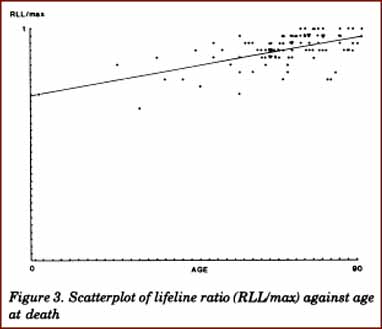
A close association was demonstrated by regression analysis which yielded the following equation which was not materially improved by incorporation of data from the left hand:
Age at death = 105*(RLL/max)-27
Additional statistics for slope: F-value=42,03, P<0.00000001; 95% confidence intervals 73-138.
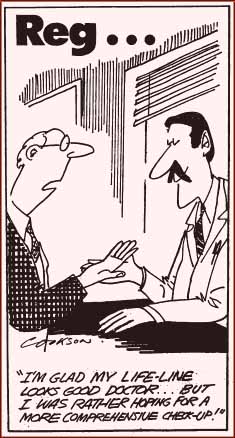
Doctor gives patient a 'life line check-up'. |
What can we learn from those results?
The researchers describe the following in their discussion: " Palmistry has been the focus of heated argument since the first mention of its techniques in Indian and Chinese manuscripts of at least 3000 years ago. The science and popularity of the subject were brought to their peak by society palmist Louis Hamon, either better known by his pseudonym of Cheiro. Cheiro made many predictions from scrunity of his clients' palms including forecasting the course of the career of the famous barrister Marshall Hall, and the dates of death of Queen Victoria and King Edward VII. Not moving in such elevated circles we have not attempted to test such predictions. The present study has therefore attempted an evaluation of a single aspect of palmistry, namely, the relationship between length of lifeline and longevity. We have minimized the effect of hand size (ie the bigger your hands the longer you live) by expressing the length of the lifeline as a ratio of the theoretical maximum it could run. Using this ratio we have found a strong statistical correlation, particularly for the right hand, and age at death." |
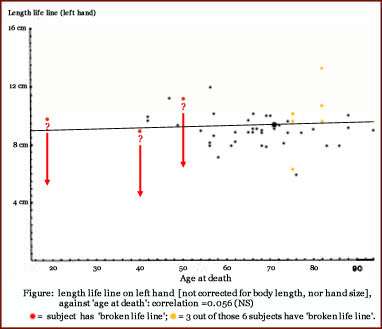
Scatterplot of lifeline vs. age for left hand (Wilson & Mather, 1974). |
• The researchers described that they found positive correlations between for the length of the life line and 'age at death', for both the right and left hand - however the strength of the effect is far from 'significant' (P=o.05). After correction for body length the correlations were still positive, but not even close to 'significant'. The data for the left hand is presented in the figure on the left.
• Interestingly, the researchers also revealed that in 6 subjects they have found an 'interrupted life line in one hand'; however ... they decided in these cases to use the full length of the life line. Maybe the researchers should have wondered: "...would Cheiro have ignored the break in the 'line of life' as well???" Anyway, in the figure on the left, anybody can notice that: the 2 subject who died at the youngest age... both had an 'interrupted life line in one hand'!!! |
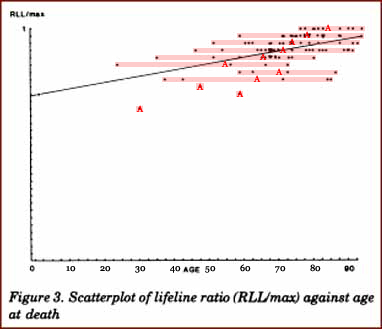
1990 Study: average age of death (A) for equal life line length groups (pink color zones) reveals a strong link! |
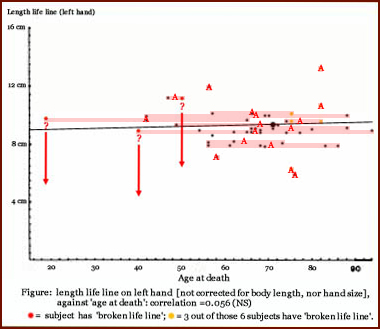
1978 study: average age of death (A) for equal life line length groups (pink color zones) reveals no link. |
4 - WHAT DESCRIBED CHEIRO ABOUT THE LENGTH OF THE LINE OF LIFE?
As stated before, Cheiro associated the length of the life line with the length of the natural life expectancy apart from accidents.
To learn and understand his style of thinking we can study some of his related quotes from his most famous work: Cheiro's The Language of the Hand (originally published in 1900):
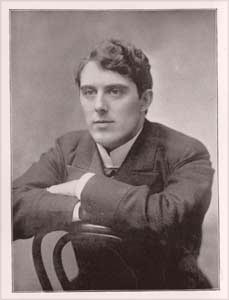
Cheiro made various comments regarding the length of the life line. |
Part II, chapter I: 'A Few Remarks in Reference to the Reading of the Hand', page 70-71:
"The chief point of difference between my teachings and those of other writers lies in the fact that I class the varous lines under different heads, treating of each particular point. This will be found not only more easy and less puzzling for the student, but also more in accordance with reason. For instance, I hold that the Line of Life relates to all that affects life, to the influences which govern it, to its class as regards strength; to the natural length of life, and to the important changes of country and climate. I regard the line of head as related to all that affects mentality, and so on with every other line, as will be seen later. " Part II, chapter V: 'The Line of Life', page 80: "The Line of Life should be long, narrow, and deep, without irregularities, breaks, or crosses of any kind. Such a formation promises long life, good health, and vitality." |
5 - CHEIRO'S HANDPRINT: HOW LONG WAS HIS LIFELINE?
Cheiro presented his own handprint in his famous 'Cheiro's language of the hand': see the picture below!
(For your information: Cheiro presented only the palmprint of his right hand in his books)
Interestingly, Cheiro's life line is clearly visible on the print - which provides us the opportunity to make a 'life line analysis':
The handprint indicates that Cheiro's life line starts out outside of the palm (between the thumb and the index finger),
while his life line appears to end at a point close to the border of the lower quarter of the mount of Venus (tenar).
The first bracelett (racette) in his wrist is just visible on the print (only a few mm's from where the printet area of his palm ends).
NOTICE: Cheiro did not have an interruption in his life line (but he did have a 'splitting life line' - the potential effect of that aspect is not clear).
Now, take a look at Cheiro's palmprint & read further below...
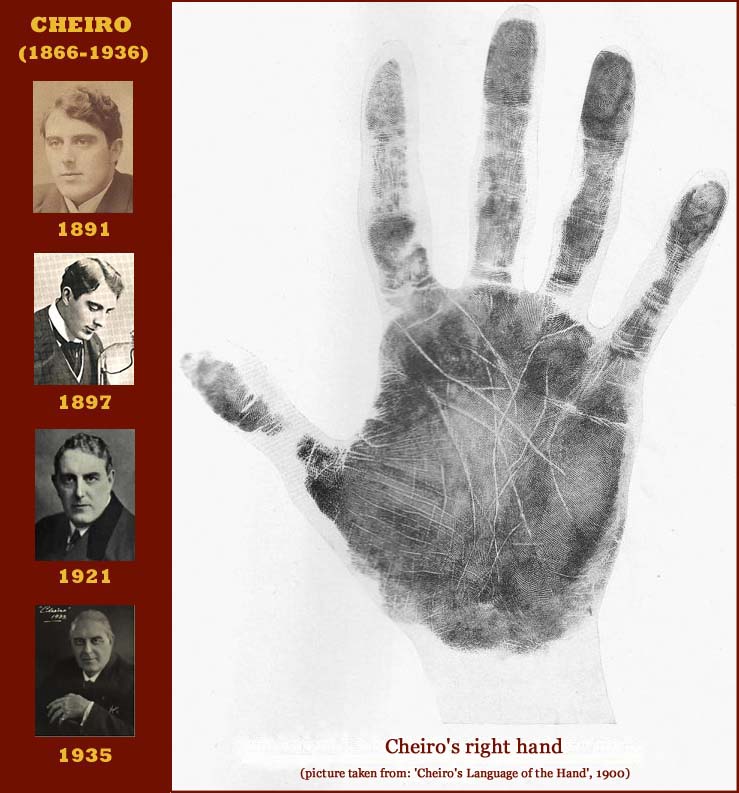
Cheiro's handprint: how long is his 'Line of Life'?
When using the measurement method described in the 2th paragraph of this article, one could find that Cheiro's 'CORRECTED LIFELINE RATIO' is close to: 0.82 (= RLL/max).
The inclusion of that result in the formula presented by the researchers gives:
(Cheiro's) age at death = 105*(RLL/max)-27 = 105*(0.82)-27 = 59.1 years
CONCLUSION:
Cheiro (1866-1936) died at age 70 - about 10 years later than indicated by the length of his lifeline.
So likely, we can safely conclude... that Cheiro outlived the length of his own 'Line of Life'!
(Which sort of confirms again that the life line in an individual is not a reliable indicator for the person's 'life span'!)
NOTICE:
This article presents confirming reassurence for readers (and other people) who discovered that the length of their 'Line of Life' is rather short:
because even the 'Godfather of palmistry' lived longer than indicated by his theory... and the length of his life line!
PS. The same can be said about the majority of the people included in the British sample: almost 60% of those outlived their 'Line of Life'.
SOURCES:
• FULL ARTICLE: 'Relationship between longevity and lifeline: a manual study of 100 patients.'
• BUY AT AMAZON: Cheiro's The Language of the Hand
ADDITIONAL REVIEWS OF THE 1990 RESEARCH:
• C.L. Jones: 'Lifeline and longevity'
• S. Lewis: 'Relationship between lifeline and longevity'
• J. Verbov: 'I don't fancy palmistry'
|
More articles presented by handresearch.com about the simian line: |
|
|
© COPYRIGHT 2002-2017: |